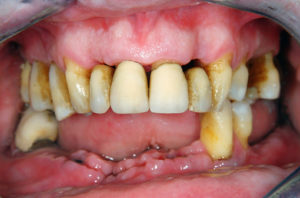
Periodontal disease is caused by infection by invasive oral bacterial pathogens. These bacteria form dental plaque biofilms on the tooth surfaces that triggers an immune response. The persistent immune response causes the gums to become inflamed, eventually leading to gum recession and bone loss. The end result of periodontal disease is tooth loss if the disease is left untreated. To treat periodontal disease, your dentist will recommend dental scaling and root planning as the first line of defense. Scaling and root planning is the gold standard for treating periodontal disease. However, scaling and root planning may not be able to completely remove bacterial biofilms that causes inflammation from sites where access is poor. Plaque and calculus removal in deep pockets are more difficult than shallow pockets. When the pathogen source is left untreated, the periodontal disease can get worse. To reach these deep pockets, your periodontist may recommend treating periodontal disease with antiseptic mouth rinse. Dental research studies have shown that treating periodontal disease with ozone and chlorohexidine antiseptic mouth rinses is effective at preventing chronic periodontitis.
How does ozone and chlorohexidine antiseptic mouth rinse help prevent periodontists?
Ozone
Ozone is a natural gas that has three oxygen atoms instead of two. Ozone is a powerful oxidizing agent with antimicrobial activity against many oral pathogens. The antimicrobial activity of ozone works by destroying the bacteria’s cell wall. When the bacteria’s cell wall is destroyed, the bacteria will burst. Studies that investigated the effectiveness of ozone treatment show that when dental plaque was treated with ozonated water it killed the microbes. The antimicrobial action of ozone is selective against microbial cells and will not damage human body cells. An added benefit of ozone is that it can improve metabolism of the inflamed tissue by increasing oxygenation to reduce inflammation.
Chlorhexidine
Chlorohexidine is a widely used antimicrobial agent can is available in different forms. The Chlorohexidine at high concentration of 0.12% or more have very good antimicrobial activity, causing lethal damage to the bacteria’s cell membrane. Disrupting the cell membrane of bacteria causes the cell to erupt. Chlorohexidine is also used in preventing infections after tooth extractions in case of post-extraction complications.
How does chlorohexidine and ozone improve periodontal treatment?
The addition of ozone or chlorohexidine treatment can help prevent chronic periodontitis. Four general characteristics of improved periodontal treatment that your periodontist will examine are reduced plaque accumulation, gum health, gum attachment to the teeth, and reduced periodontal pockets. After undergoing dental scaling and root planning, your dentist may recommend additional treatment using ozone or chlorohexidine to prevent chronic periodontitis. Treating periodontal disease using antiseptic agents is effective at reaching hard to spots and less evasive method used by your dentist to manage the disease.
If your gums bleed more than usual or concern about the health of your gums, give California Dental Group a call at 800-407-0161 to schedule your appointment.

